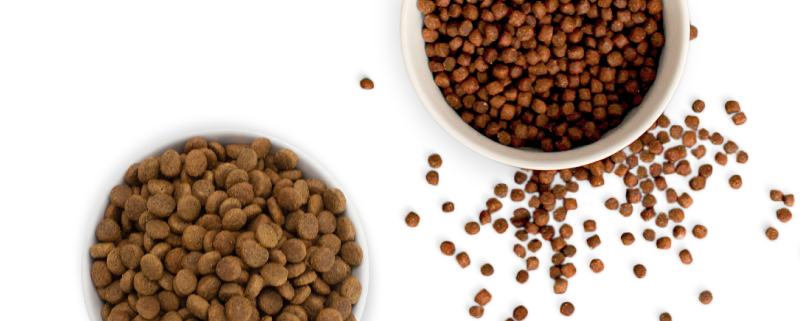With pet shop shelves stacked with a crazy amount of different dog foods, it can be overwhelming to make the correct choice for your pup. Understanding the pet food industry a little better can help you give your pup a healthy dog food diet. So, let’s dive into some dog food facts that will inform your decision of what to feed your doggo to keep that tail wagging
The correct nutrients
First and foremost, the requirement of any dog food is to give your pup the nutrients they need to thrive. But how do you know what to look for? At OMNI we cut through the noise by being totally transparent about what’s in our plant-based dog food and how it benefits your pup. Here are a few of our key ingredients…
- Blueberries are an excellent source of antioxidants, fibre and vitamins C and K.
- Cranberries may help stop urinary tract infections by preventing the bacteria and fungi from latching onto the wall of the urinary tract.
- Yeast is a superfood for dogs that is packed with all 10 essential amino acids that a healthy dog needs to thrive. It is also rich in fibres like beta-glucans and B vitamins which promote excellent gut health in dogs.
- Lentils are high in fibre making them the perfect choice for hungry dogs, as they tend to leave your dog feeling fuller for longer. They’re also a rich source of protein.
- Microalgae is a super food and a great source of protein, fatty acids, antioxidants, vitamins, minerals and fibre.
- Sweet potatoes are highly nutritious and loaded with lots of vitamins and minerals too including Vitamin A, C, B3, B5, B6 manganese and copper.
Fixed Formula
Keeping your eye out for fixed formula dog food is another quick tip to make sure you’re giving your pup the best food that is less likely to trigger allergies or sensitivities. This is because fixed formula food contains exactly the same ingredients in each batch to prevent gastrointestinal upset. In most open formula meat-based food the animal derivatives are switched around to make up protein content based on what is cheapest at the time. However, OMNI contains exactly the same ingredients in each yummy batch to take care of your pup's tummy so there aren’t any sudden changes in their diet. Read more about fixed formula dog food in our blog here.
High Temperatures
In some extrusion cooking processes, ingredients are heated at up to 320°F, to stop food from going off as quickly. However, the disadvantage of this is that it can significantly reduce the nutrient value of the food. In particular, this can deplete vitamins A, E and B and even protein.
That’s why at OMNI the ingredients in our vegan dog food are gently steam baked at 90°C to maintain the vitality of the ingredients. Not only that, but one of our key ingredients, carrots, contains beta carotene which dogs convert to Vitamin A. Pumpkin is also part of our recipe meaning OMNI is rich in vitamin A while oats contain vitamin B1 and vitamin E. This means that you can rest assured that OMNI is one of the healthy dog food options for your pup, bursting with nutrients.
What’s not on the label
When the food is cooked over 280°F, a reaction called “advanced glycation end product” - known as AGE’s - can be produced. In humans, AGE’s are linked to advanced ageing and diseases such as diabetes, chronic kidney disease and Alzheimer's. Shockingly, studies suggest some modern dog foods contain more than 100x AGE’s than a standard human diet. These AGE’s are thought to cause inflammation which could be connected to excessive itching and joint discomfort. It has even been reported that they may play a role in causing cancer.
As AGE’s are a bi-product of cooking at high temperatures, they do not have to be listed on the label. That’s why it’s super important to give your pup food that is high in antioxidants to combat inflammation. At OMNI our recipe contains microalgae, sweet potatoes, blueberries and pumpkin that are rich in antioxidants giving you peace of mind that your dog is being looked after from the inside out.
The requirements
Outside of essential vitamins, pet foods have zero requirements for antioxidants but that doesn’t mean that they’re any less important. There are also no requirements for polysaccharides that support the immune system or omega 3 & 6.
Don’t worry because not only does the OMNI recipe include antioxidants, but we also have carrots, potato protein, peas and blueberries to aid the immune system. The sunflower and rapeseed oil in our recipe is also naturally rich in omega 3 & 6.
We’ve got you covered
Despite all the concerning loopholes in the pet food industry, at OMNI we want to see your pup live a healthy and happy life. Our vet-formulated, nutritionally complete plant-based dog food will give your pup what they need to thrive whilst we are always striving to remain completely transparent.
Join the community of happy doggo parents and subscribe to OMNI for delicious, healthy dog food delivered to your door. Not only that, with a subscription you’ll get complimentary access to a bespoke health plan for your pup and monthly vet consultations. Let’s take care of your pup together!
References
1. https://amazingdoghealth.com/ways-to-help-dog-live-longer/

